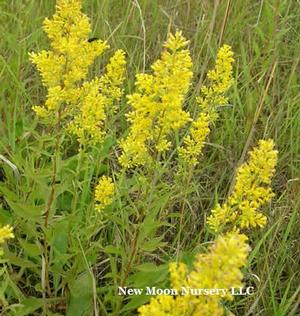New Moon Nurseries
Solidago speciosa
Showy goldenrod
Native to North America
FIRST IMPRESSIONS: Solidago speciosa is an unbranched clumping perennial wildflower with narrowly oval foliage. From late summer until autumn, plants are topped by attractive pyramidal golden-yellow flower panicles. This lovely goldenrod prospers in sunny moist or dry well-drained sites.
HABITAT & HARDINESS: Solidago speciosa occurs from New Hampshire to Georgia and west to Wisconsin, Illinois, Kansas, Oklahoma and Louisiana.
Plants are indigenous to mesic to dry Blackland prairies, sand prairies, clearings and edges of rocky upland woods, Black oak savannas, thickets and old fields.
Plants are hardy from USDA Zones 3-8.
PLANT DESCRIPTION: Solidago speciosa is an erect vase shaped perennial with smooth reddish or green stems.
Leaves are alternate and up to 6” long and 1½” across. Blades are narrow and lance shaped or oblong. They have smooth edges and little or no pubescence. The upper leaves have small wing-like leaflets that form in the axils.
The inflorescence is showy and unusual with a very erect plume-like form. The bright yellow panicles are dense and about 1’ long. They are packed with many ¼” flowerheads. Each head contains 4-10 ray florets surrounding a cluster of disc florets.
Blooming begins in late summer or early autumn and continues for about a month. The florets mature into small achenes crowned by tufts of hair.
Plants grow 3-5’ tall with a spread of 2-3 feet. Plants spread at a moderate rate from underground rhizomes.
CULTURAL & MAINTENANCE NEEDS: Solidago speciosa thrives in sunny well drained, sandy or loamy soils. Plants tolerate light shade, drought, poor infertile soils and rocky or clay soils
Plants proliferate from rhizomes but are generally not considered to be invasive. In moist overly fertile soils, however, this species can spread somewhat aggressively or can flop due to weak rapid growth.
If seedlings are a problem, deadhead to remove spent flower before the seed ripen.
This species is relatively pest free except for an occasional bout with powdery mildew.
LANDSCAPE USES: Solidago speciosa is considered by many to have the most spectacular flower display of the approximate 125 species of native goldenrods. It creates an exceptional show when planted as an Accent, Grouping or Mass in Wildlife Gardens, Meadows or Perennial Borders. This goldenrod also serves as a Butterfly Nectar Plant and is appropriate for Cottage Gardens, Cut Flower Gardens, Low Maintenance Plantings, Roadsides and Restoration Projects.
COMPANION & UNDERSTUDY PLANTS: Try pairing Solidago speciosa with Andropogon gerardii, Aster laevis, Eryngium yuccifolium, Eupatorium hyssopifolium Liatris aspera or Sporobolus heterolepis.
Solidago rugosa has similar height, cultural needs and season of bloom and is a worthy substitute.
TRIVIA: Solidago speciosa provides valuable late season nectar and pollen for native bees, honeybees, butterflies, moths and beetles. Plants host caterpillars of several moth species. Seed are eaten by the Eastern Goldfinch and Greater Prairie Chicken. Young foliage is occasionally nibbled by White-tailed Deer and other herbivores.
Plants are occasionally infected by a fungus that causes sickness and death in livestock.
Solidago speciosa can be distinguished from other goldenrods by the unusual shape of the inflorescence. The side stalks of the panicle are erect or curved upward while most other goldenrod flower stems curve outward or down. It also has stems and leaves that lack pubescence, leaves with smooth margins and small wing-like leaflets in the upper leaf axils.
Height:
3-5 ftSpread:
2-3 ftSpacing:
36-48 inUSDA Hardiness Zone:
3-8Bloom Color:
YellowSolidago speciosa Characteristics
Attracts Wildlife
- Butterflies
- Songbirds
- Pollinators
Attributes
- Dried Flower
- Cut Flower
- Coastal
- Clay Soil
- Rock Garden
- Naturalizing
- Drought Tolerant
Exposure
- Full Sun to Partial Shade
Flowering Months
- October
- September
Foliage Color
- Green
Growth Rate
- Medium
Juglans nigra Tolerance (Black Walnut)
- Yes
Salt Tolerance
- Medium
Season of Interest (Foliage)
- Fall
- Summer
- Spring
Soil Moisture Preference
- Moist to Dry
Interesting Notes:
For more information on this plant, visit the USDA PLANTS Database: http://plants.usda.gov/java/profile?symbol=SOSP2
